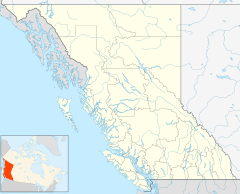Churn Creek Protected Area facts for kids
Quick facts for kids Churn Creek Protected Area |
|
|---|---|
|
IUCN Category VI (Managed Resource Protected Area)
|
|
 |
|
| Location | British Columbia, Canada |
| Area | 36,747 ha (90,800 acres) |
| Established | 1995 |
| Governing body | BC Parks |
The Churn Creek Protected Area is a special natural space in British Columbia, Canada. It covers a huge area of about 36,747 hectares (that's over 90,000 acres!). This protected area is a mix of dry canyons, wide-open grasslands, and areas used for ranching.
It's located where Churn Creek meets the mighty Fraser River. This spot is at the northern tip of the Camelsfoot Range mountains. Just north of the protected area is the historic Gang Ranch. Later, the Empire Valley Ranch was added to make the protected area even bigger.
Contents
Where is Churn Creek Protected Area?
This amazing protected area is found in the southwestern part of British Columbia. It's in the Cariboo region, right on the southern edge of the Chilcotin Plateau.
The park includes most of the land where Churn Creek flows. Its eastern border is the famous Fraser River. The southern part of the park also covers a large section of the Fraser River's western bank. This includes the lower parts of smaller creeks like Grinder and Lone Cabin. You'll also find several small lakes here.
The land is carved deeply by rivers and creeks, forming canyons and flat areas called benchlands. The Camelsfoot Range mountains in the west of the park rise to more than 1,500 meters (about 4,900 feet) high. The Churn Creek canyon has cool rock formations, like tall pillars and hoodoos. These are natural rock columns shaped by erosion.
A Look Back: History of the Area
The Churn Creek area has been home to First Nations people for at least 7,000 years. The Tsilhqot'in and Secwepemc peoples lived here for a very long time.
In the mid-1800s, people from Europe started moving into the Cariboo region. This happened after gold was discovered there. Sadly, they brought the smallpox virus with them. The First Nations people had no protection against this disease. The population of the Tcexwe'ptem band in the Empire Valley was greatly reduced by smallpox in the 1860s. The people who survived joined other bands nearby.
Ranching became a very important way of life in this area. Two big ranches, the Empire Valley and the Gang Ranch, were started around Churn Creek in the late 1800s.
Protecting the Land: Conservation Efforts
Parks Canada first thought about making Churn Creek a national park. They were interested because of the many bighorn sheep and other animals living there. However, local ranchers didn't want a national park, so it didn't happen then.
In the 1990s, the Province of British Columbia looked at the area again. They wanted to protect its natural resources. The province worked with the ranchers to find a solution. They agreed to set aside certain areas within the park where cattle could still graze.
The Churn Creek Protected Area was officially created in 1995. It was made even larger in 1997 when the former Empire Valley ranch was added. This protected area is one of five in British Columbia that helps protect important grassland areas.
Amazing Nature: Ecology of Churn Creek
Churn Creek Protected Area is home to many different plants and animals. It's a great place to learn about nature!
Plants of the Park: Flora
In the lower grassland areas, you'll mostly see a type of grass called bluebunch wheatgrass. You'll also spot clumps of big sagebrush. Lichens and mosses are very common here. They can cover up to 80% of the ground under and around other plants.
As you go to higher places, you'll start to see more Interior Douglas fir trees. These evergreen trees cover a lot of the land. Deciduous trees, like aspen and poplar, also grow in small groups called copses. You'll often find them near rivers, creeks, and lakes.
Animals of the Park: Fauna
Several groups of bighorn sheep live in the park. Some stay all year, while others travel to nearby mountain areas in the summer. You can also find mule deer here.
The grasslands are home to many birds, bats, small rodents, and reptiles. Some of the birds you might see include the Brewer's sparrow, Lewis's woodpecker, long-billed curlew, gyrfalcon, short-eared owl, and prairie falcon.
Bats like the Western small-footed myotis live here too. For reptiles, look out for the rubber boa and the gopher snake. In the forests, you might find the flammulated owl, Townsend's big-eared bat, and sharp-tailed grouse.



